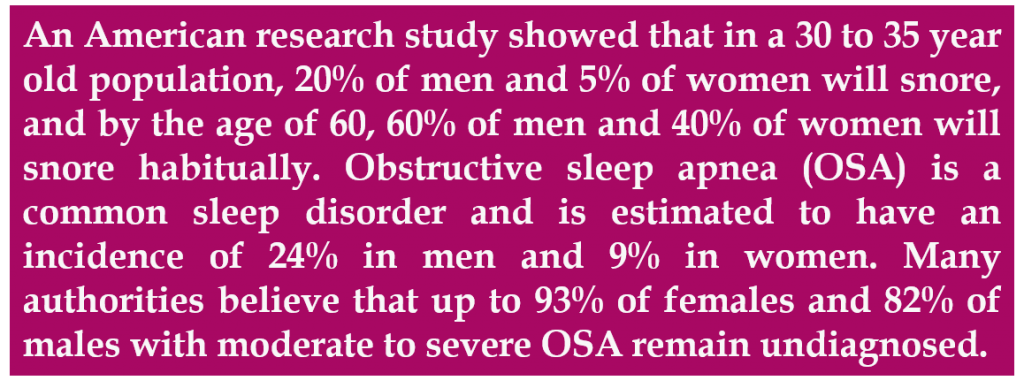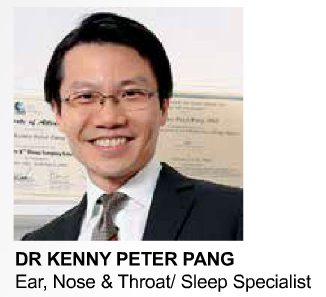
Dr Kenny Pang, Ear Nose & Throat, Sleep Specialist of Asia Sleep Centre shares with us why SNORING is the Silent Killer!

 Snoring is frequently deemed as a social nuisance. Not a nuisance to the snorer, but a nuisance to the bed-partner. The presence of snoring is an ‘alarm’ that alerts one to the possibility of a sleep disorder. It is due to the vibration of the tissues in the mouth and oral cavity (namely the soft palate, uvula, base of tongue and other soft tissues).
Snoring is frequently deemed as a social nuisance. Not a nuisance to the snorer, but a nuisance to the bed-partner. The presence of snoring is an ‘alarm’ that alerts one to the possibility of a sleep disorder. It is due to the vibration of the tissues in the mouth and oral cavity (namely the soft palate, uvula, base of tongue and other soft tissues).
Snoring implies an increased resistance to the inflow of air during breathing at the level of the upper airways.
Patients with adenotonsillar hypertrophy have a crowded upper airway with very little space for airflow, while obese patients frequently have a thick and fatty soft palate. It is the vibration of these soft tissues during sleep that results in snoring, when the bulk of this soft tissue exceeds a certain amount. Snoring is caused by a vibration of the structures of the oral cavity, oropharynx, soft palate, uvula, tonsils, base of tongue, epiglottis and pharyngeal walls. Occasionally, this leads to collapse, partial or complete, of these structures, which then leads to upper airway obstruction during sleep. Patients with a small jaw will also have less space available, therefore increasing the likelihood of airway compromise during sleep.
Nasal pathologies have been shown to aggravate and contribute to the severity of SDB, and treatment of the underlying nasal pathology may help, but usually not cure the disorder. There is a male predominance in OSA, this may be partly a result of hormonal differences since post-menopausal women tend to develop symptoms on average five years after menopause, with a prevalence of OSA approaching that of males. There are some reports that progesterone (female hormones) will reduce snoring and sleep apnea in males, while exogenous testosterone can increase upper airway resistance in females.
Commonest clinical symptom for patients with OSA is snoring.
Frequently, the sleep partner prompts the patient to see a physician because of concerns over repeated apneas (stoppages in breathing). Patients may complain of frequent awakenings with a choking and gasping sensation, nocturia (frequent passing urine at night), or nightmares. Many bed partners have witnessed their partners choking and holding their breaths during their sleep. Patients with severe OSA may be unable to sleep supine, as this causes the tongue to fall backwards resulting in obstruction of the airway. Common patient complaints include early morning tiredness and morning headaches (attributable to the repetitive nocturnal low oxygen levels). Morning dry mouth and throat are caused by mouth-breathing and snoring. Other symptoms include forgetfulness, depression, irritability and, less commonly, impotence.
Excessive daytime sleepiness is very common in patients with OSA, and is caused by a combination of frequent arousals, sleep fragmentation, repetitive oxygen desaturations, and reductions in delta and rapid eye movement (REM) sleep. Excessive daytime sleepiness can be measured by a simple questionnaire known as the Epworth’s Sleepiness Score (ESS) (see figure below).
The commonest symptoms related to obstructive sleep apnea are:
During the day:
Daytime sleepiness, tiredness
Poor concentration
Poor memory
Morning headaches
Mood changes
Irritability
During the night:
Choking sensation at night
Gasping for air at night
Frequent arousals
Nocturia (frequent passing urine)
Loud snoring
Evaluation of Snoring Patients
Clinical evaluation is the most important step in managing a patient with snoring and/or sleep apnea. An ear, nose and throat endoscopic examination of the upper airway assessment is crucial. All patients should have weight and height recorded, body mass index (BMI) calculated, blood pressure taken, and neck circumference measured.
Patients with snoring/sleep apnea can be divided into 2 main groups:
• Those with a GLOBAL problem (patients with gross obesity, thick fat in the neck), and
• Those patients with a LOCAL problem (patients who are not obese but with big tonsils, a big tongue, and/or a thick redundant palate), and
• Those patients who OVERLAP, they are obese and also have a local problem, like obesity or a thick neck.
The upper airway assessment is the most important step in the evaluation of the snoring patient. This would be fundamental, in assessing and deciding the modality of treatment in all snoring / sleep apnea patients.
Anatomy to be observed:
 1. Nose swelling – the nose is physiologically essential in breathing, any swelling within the nose needs to be corrected in order for normal breathing to be restored.
1. Nose swelling – the nose is physiologically essential in breathing, any swelling within the nose needs to be corrected in order for normal breathing to be restored.
2. Tonsil size – the patient’s tonsils are assessed with regards to how obstructing they are. They are graded based on their size within the oral cavity.
3. Tongue size – the tongue is very essential in the evaluation, as the tongue is the final “gate-keeper” to the opening of the lungs. If it is obstructing, it would have to be treated.
4. Palate thickness – if the palate was too thick or redundant, it would not only cause loud snoring but may lead to obstruction of the airway and hence, sleep apnea.
Based on the patient’s BMI, neck circumference, oral cavity adequacy, tonsil size, palate size / length, tongue size, upper airway assessment, and the nasal passage size, the modality of treatment is decided together with the patient.
How Does Sleep Apnea Kill?
Nightmare time comes in the wee hours of the morning for people with obstructive sleep apnea. But it’s no dream: That’s when they’re at highest risk of sudden death. It has been said that “Sleep apnea is the phantom cause of heart disease and sudden death”. It is well known that patients with sleep apnea have a 6 times higher risk of dying between midnight and 6am, compared to normal non-apneic patients. As these patients with snoring and sleep apnea have numerous dips in their oxygen levels while asleep, it would not be surprising that they suffer from significant stress on the heart and brain during these low oxygen events. This in turn leads to high blood pressure, lack of oxygen in the blood and hence, strokes, heart attacks and sudden death.
In general, people with sleep apnea syndrome have a higher risk of death than the normal population. The price they pay includes a potentially crippling deterioration in daily functioning, an increased risk of high blood pressure and stroke, depression, and death either in accidents or in their sleep. The family of the person with sleep apnea syndrome will also be affected, as the patient may experience irritability, mood changes, lowered sexual drive, and a reduction of intellectual ability. In addition there are major business, insurance, health, and social costs including the loss of productivity, the impact of accidents caused by a driver or worker falling asleep, and the wasted health care dollars spent on alleviating symptoms like heart disease without treating their possible underlying cause.
Overall, it is well known that patients with sleep apnea would not live as long as people without sleep apnea. Medical research has shown that patients with severe obstructive sleep apnea (patients who stop breathing more than 30 times per hour) have a mortality rate of about 3% per year, studies done over 10 years (Marti et al).
This article was first published in our Parenting With Love Guide, click here to read.






